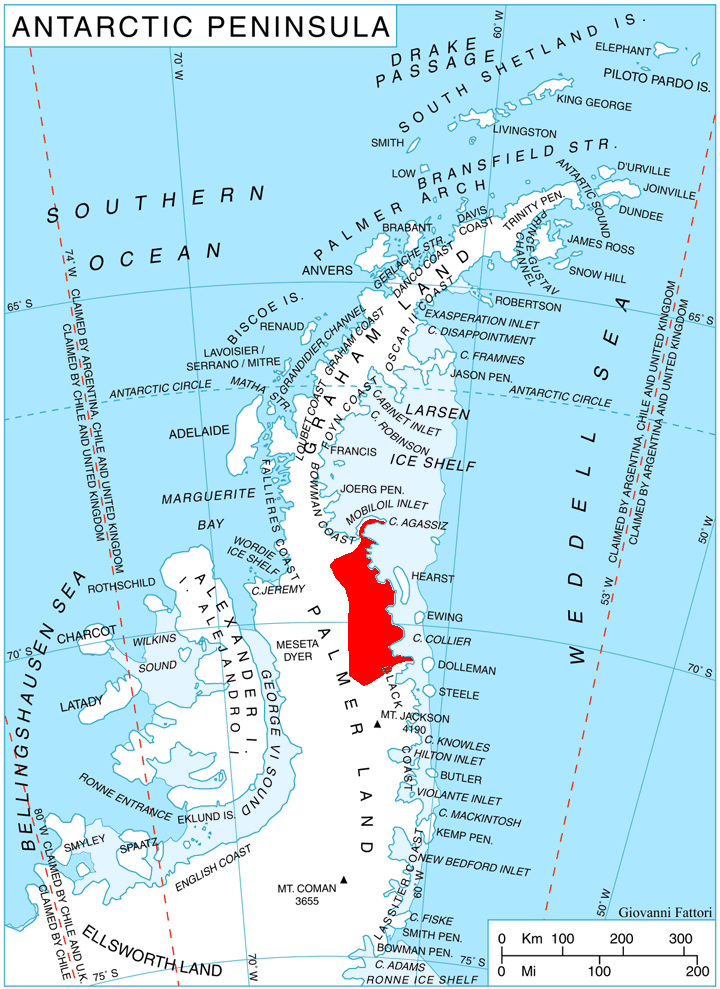|
Bertius Inlet
Bertius Inlet ( bg, text=залив Бертий, italic=no, ‘Zaliv Bertius’ \'za-liv 'ber-tiy\) is the 8.3 km wide ice-filled inlet indenting for 9 km Wilkins Coast on the Antarctic Peninsula. It is entered south of Cape Walcott and north of Cape Hinks, and has its head fed by Lurabee Glacier. The feature is named after the Flemish geographer and cartographer Petrus Bertius (Pieter de Bert, 1565–1629) who published an early separate map of Terra Australis Incognita in 1616. Location Bertius Inlet is centred at . British mapping in 1963 and 1976. Maps *British Antarctic Territory. Scale 1:200000 topographic map. DOS 610 Series, Sheet W 69 62. Directorate of Overseas Surveys, Tolworth, UK, 1963. *British Antarctic Territory: Palmer Land. Scale 1:250000 topographic map. BAS 250 Series, Sheet SR 19–20. London, 1976. Antarctic Digital Database (ADD).Scale 1:250000 topographic map of Antarctica. Scientific Committee on Antarctic Research (SCAR). Since 1993, regular ... [...More Info...] [...Related Items...] OR: [Wikipedia] [Google] [Baidu] |
Wilkins Coast
Wilkins Coast is that portion of the east coast of the Antarctic Peninsula between Cape Agassiz and Cape Boggs. It was named by the Advisory Committee on Antarctic Names (US-ACAN) for Sir Hubert Wilkins, who in a pioneer Antarctic exploratory flight on December 20, 1928, flew southward from Deception Island and crossed the Antarctic Peninsula to its east side. He continued southward to Stefansson Strait Stefansson Strait () is an ice-filled strait 35 nautical miles (60 km) long and 3 to 10 nautical miles (18 km) wide, between the east coast of Palmer Land, there called ''Wilkins Coast'', and Hearst Island. This strait was first sighted b ... and Hearst Island, which lie midway along Wilkins Coast. Coasts of Palmer Land {{PalmerLand-geo-stub ... [...More Info...] [...Related Items...] OR: [Wikipedia] [Google] [Baidu] |
Antarctic Peninsula
The Antarctic Peninsula, known as O'Higgins Land in Chile and Tierra de San Martín in Argentina, and originally as Graham Land in the United Kingdom and the Palmer Peninsula in the United States, is the northernmost part of mainland Antarctica. The Antarctic Peninsula is part of the larger peninsula of West Antarctica, protruding from a line between Cape Adams (Weddell Sea) and a point on the mainland south of the Eklund Islands. Beneath the ice sheet that covers it, the Antarctic Peninsula consists of a string of bedrock islands; these are separated by deep channels whose bottoms lie at depths considerably below current sea level. They are joined by a grounded ice sheet. Tierra del Fuego, the southernmost tip of South America, is about away across the Drake Passage. The Antarctic Peninsula is in area and 80% ice-covered. The marine ecosystem around the western continental shelf of the Antarctic Peninsula (WAP) has been subjected to rapid climate change. Over the past ... [...More Info...] [...Related Items...] OR: [Wikipedia] [Google] [Baidu] |
Cape Walcott
Cape Walcott is a bold, ice-covered headland rising to 625 m on the north side of the entrance to Bertius Inlet, and forming the seaward extremity of Scripps Heights on the east coast of Palmer Land. Discovered by Sir Hubert Wilkins in 1928 and named by him for Frederic C. Walcott Frederic Collin Walcott (February 19, 1869April 27, 1949) was a United States senator from Connecticut. Biography Born in New York Mills, Oneida County, New York, the son of William Stuart Walcott and Emeline Alice Welch Walcott, Walcott atten ... of the Council of the American Geographical Society. Headlands of Palmer Land {{PalmerLand-geo-stub ... [...More Info...] [...Related Items...] OR: [Wikipedia] [Google] [Baidu] |
Cape Hinks
Stefansson Strait () is an ice-filled strait 35 nautical miles (60 km) long and 3 to 10 nautical miles (18 km) wide, between the east coast of Palmer Land, there called ''Wilkins Coast'', and Hearst Island. This strait was first sighted by Sir Hubert Wilkins at the south end of his flight of December 20, 1928, and was named by him for Vilhjalmur Stefansson. He believed it to be a strait cutting off what is now known to be Antarctic Peninsula The Antarctic Peninsula, known as O'Higgins Land in Chile and Tierra de San Martín in Argentina, and originally as Graham Land in the United Kingdom and the Palmer Peninsula in the United States, is the northernmost part of mainland Antarctic ... from the main land mass of Antarctica. The true orientation of the strait was determined by members of the United States Antarctic Service (USAS) who charted this coast by land and from the air in 1940. Straits of Antarctica Bodies of water of Palmer Land {{PalmerLand-geo-st ... [...More Info...] [...Related Items...] OR: [Wikipedia] [Google] [Baidu] |
Lurabee Glacier
Lurabee Glacier () is a glacier long, flowing northeast between the Scripps Heights and Finley Heights to the east coast of Palmer Land, Antarctica. This glacier was discovered by Sir Hubert Wilkins on December 20, 1928, on his pioneer Antarctic flight. He named it "Lurabee Channel" for Lurabee Shreck of San Francisco, in recognition of her aid in procuring equipment for this and an earlier Arctic flight, and for her editorial assistance on his book ''Flying the Arctic''. The term channel has been amended to glacier, in keeping with the true nature of the feature. See also *Hogmanay Pass Hogmanay Pass () is a pass high, immediately southwest of the Scripps Heights, leading from the head of Casey Glacier to the middle of Lurabee Glacier, in northeastern Palmer Land, Antarctica. The feature was first photographed from the air by Li ... References Glaciers of Palmer Land {{PalmerLand-geo-stub ... [...More Info...] [...Related Items...] OR: [Wikipedia] [Google] [Baidu] |
Flemish People
The Flemish or Flemings ( nl, Vlamingen ) are a Germanic ethnic group native to Flanders, Belgium, who speak Dutch. Flemish people make up the majority of Belgians, at about 60%. "''Flemish''" was historically a geographical term, as all inhabitants of the medieval County of Flanders in modern-day Belgium, France, and the Netherlands were referred to as "Flemings", irrespective of their ethnicity or language. The contemporary region of Flanders comprises a part of this historical county, as well as parts of the medieval duchy of Brabant and the medieval county of Loon, where the modern national identity and culture gradually formed. History The sense of "Flemish" identity increased significantly after the Belgian Revolution. Prior to this, the term "Vlamingen" in the Dutch language was in first place used for the inhabitants of the former County of Flanders. Flemish, however, had been used since the 14th century to refer to the language and dialects of both the peoples ... [...More Info...] [...Related Items...] OR: [Wikipedia] [Google] [Baidu] |
Petrus Bertius
Petrus Bertius (also Peter Bertius; Pieter de Bert) (14 November 1565 – 13 October 1629) was a Flemish philosopher, theologian, historian, geographer and cartographer. Bertius published much in mathematics, and historical and theological works, but he is now best known as cartographer with his edition of the '' Geographia'' of Ptolemy (based on Mercator's edition from 1578), and for its atlas. Early life He was born in Beveren (Alveringem), the son of a Flemish preacher Pieter Michielszoon Bardt, who left Flanders for religious exile in London around 1568, with his family. In 1577 Petrus Bertius returned to the Netherlands, to study at the University of Leiden. He supported himself by tutoring younger students and continued travelling in Europe. In 1593 he was appointed to subregent of the Leiden ''Statencollege'', marrying in the same year Maritgen, daughter of Johannes Kuchlinus, the first regent of the ''Statencollege'', whom he would succeed after his death in 1606 as a ... [...More Info...] [...Related Items...] OR: [Wikipedia] [Google] [Baidu] |
Terra Australis
(Latin: '"Southern Land'") was a hypothetical continent first posited in antiquity and which appeared on maps between the 15th and 18th centuries. Its existence was not based on any survey or direct observation, but rather on the idea that continental land in the Northern Hemisphere should be balanced by land in the Southern Hemisphere.John Noble Wilford: The Mapmakers, the Story of the Great Pioneers in Cartography from Antiquity to Space Age, p. 139, Vintage Books, Random House 1982, This theory of balancing land has been documented as early as the 5th century on maps by Macrobius, who uses the term ' on his maps. Names Other names for the hypothetical continent have included ''Terra Australis Ignota'', ''Terra Australis Incognit ("the unknown land of the south") or ''Terra Australis Nondum Cognita'' ("the southern land not yet known"). Other names were ''Brasiliae Australis'' ("the southern Brazil"), and ''Magellanica'' ("the land of Magellan"). Matthias Ringmann ca ... [...More Info...] [...Related Items...] OR: [Wikipedia] [Google] [Baidu] |
Scientific Committee On Antarctic Research
The Scientific Committee on Antarctic Research (SCAR) is an interdisciplinary body of the International Science Council (ISC). SCAR coordinates international scientific research efforts in Antarctica, including the Southern Ocean. SCAR's scientific work is administered through several discipline-themed ''science groups''. The organisation has observer status at, and provides independent advice to Antarctic Treaty Consultative Meetings, and also provides information to other international bodies such as the Intergovernmental Panel on Climate Change (IPCC) and the United Nations Framework Convention on Climate Change (UNFCCC). History At the International Council of Scientific Unions (ICSU)’s Antarctic meeting held in Stockholm from 9–11 September 1957, it was agreed that a committee should be created to oversee scientific research in Antarctica. At the time there were 12 nations actively conducting Antarctic research and they were each invited to nominate one delegate to ... [...More Info...] [...Related Items...] OR: [Wikipedia] [Google] [Baidu] |
Composite Antarctic Gazetteer
The Composite Gazetteer of Antarctica (CGA) of the Scientific Committee on Antarctic Research (SCAR) is the authoritative international gazetteer containing all Antarctic toponyms published in national gazetteers, plus basic information about those names and the relevant geographical features. The Gazetteer includes also parts of the International Hydrographic Organization (IHO) General Bathymetric Chart of the Oceans (GEBCO) gazetteer for under-sea features situated south of 60° south latitude. , the overall content of the CGA amounts to 37,893 geographic names for 19,803 features including some 500 features with two or more entirely different names, contributed by the following sources: {, class="wikitable sortable" ! Country ! Names , - , United States , 13,192 , - , United Kingdom , 5,040 , - , Russia , 4,808 , - , New Zealand , 2,597 , - , Australia , 2,551 , - , Argentina , 2,545 , - , Chile , 1,866 , - , Norway , 1,706 , - , Bulgaria , 1,450 , - ... [...More Info...] [...Related Items...] OR: [Wikipedia] [Google] [Baidu] |
Antarctic Place-names Commission
The Antarctic Place-names Commission was established by the Bulgarian Antarctic Institute in 1994, and since 2001 has been a body affiliated with the Ministry of Foreign Affairs of Bulgaria. The Commission approves Bulgarian place names in Antarctica, which are formally given by the President of the Republic according to the Bulgarian Constitution (Art. 98) and the established international practice. Bulgarian names in Antarctica Geographical names in Antarctica reflect the history and practice of Antarctic exploration. The nations involved in Antarctic research give new names to nameless geographical features for the purposes of orientation, logistics, and international scientific cooperation. As of 2021, there are some 20,091 named Antarctic geographical features, including 1,601 features with names given by Bulgaria.Bulgarian Antarctic Gaze ... [...More Info...] [...Related Items...] OR: [Wikipedia] [Google] [Baidu] |






